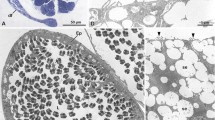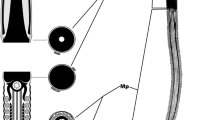Abstract
Spermiogenesis and spermatozoa in the relict trigonioid genus Neotrigonia are examined ultrastructurally. Mature Neotrigonia spp. spermatozoa exhibit the following features: (1) a blunt-conical nucleus; (2) an acrosomal complex composed of discoidal vesicles (9 to 15) arranged as a thin layer over the nuclear apex; (3) five (rarely four) spherical mitochondria positioned in depressions at the base of the nucleus; (4) proximal and distal centrioles (surrounded by the mitochondria); (5) a satellite complex anchoring the distal centriole and flagellum to the plasma membrane; and (6) a single flagellum. Spermatozoa of unionoids examined to date (Unionidae and Hyriidae only) exhibit similar features, including a nucleus with a blunt apex capped by a thin acrosomal complex (showing up to three vesicles). Among the Bivalvia, only Neotrigonia spp. and unionoid sperm possess an acrosomal complex composed of multiple vesicles. These data suggest that the Trigonioidea and Unionoidea are phylogenetically linked, but further work particularly on primitive unionoids is required to determine if this relationship is one of common ancestry or whether the Unionoidea have in fact been derived from the Trigonioidea.
Similar content being viewed by others
Literature cited
Allen, J. A. (1985). The Recent Bivalvia: their form and evolution. In: Trueman, E. R., Clarke, M. R. (eds.) The Mollusca, Vol. 10. Evolution. Academic Press, New York, p. 337–403
Baccetti, B. (1979). The evolution of the acrosomal complex. In: Fawcett, D. W., Bedford, J. M. (eds.) The Spermatozoon. Urban and Schwarzenberg, Baltimore, p. 305–328
Baccetti, B., Afzelius, B. A. (1976). Biology of the sperm cell Monographs on developmental biology. Vol. 10. S. Karger, Basel
Bernard, R. T. F., Hodgson, A. N. (1985). The fine structure of the sperm and spermatid differentiation in the brown mussel Pernaperna. S. Afr. J. Zool. 20: 5–9
Bourcart, C., Lavallard, R., Lubet, P. (1965). Ultrastructure du spermatozoide de la moule (Mytilus parma von Ihering). C. r., hebd. Séanc. Acad. Sci., Paris 260: 5096–5099
Buckland-Nicks, J. A., Chia, F.-S. (1976). Spermatogenesis of a marine snail Littorina sitkana. Cell Tissue Res. 170: 455–475
Cox, L. R. (1960) Thoughts on the classification of the Bivalvia. Proc. malac. Soc. Lond. 34: 60–88
Daniels, E., Longwell, A. C., McNiff, A. C., Wolfgang, J. M. (1971). A reinvestigation of the ultrastructure of the spermatozoa from the American oyster Crassostrea virginica. Trans. Am. microsc. Soc. 90: 275–282
Darragh, T. A. (1986). The Cainozoic Trigoniidae of Australia. Alcheringa 10: 1–34
Drozdov, A. L., Reunov, A. A. (1986). Spermatogenesis and the sperm ultrastructure in the mussel Modiolus difficilis. Tsitologiya 28: 1069–1974
Fleming, C. A. (1964). History of the bivalve family Trigoniidae in the south-west Pacific. Aust. J. Sci. 26: 196–203
Foighil, D. O. (1985). Fine structure of Lasaea subviridis and Mysella tumida sperm (Bivalvia, Galeommatacea). Zoomorphology 105: 125–132
Franzén, Å. (1955). Comparative morphological investigations into the spermiogenesis among Mollusca. Zool. Bidr. Upps. 30: 399–456
Franzén, Å. (1983). Ultrastructural studies of spermatozoa in three bivalve species with notes on evolution of elongated sperm nucleus in primitive spermatozoa. Gamete Res. 7: 199–214
Galangau, V., Tuzet, O. (1968). L'acrosome d'Octopus vulgaris L. Observations au microscope électronique. C. r. hebd. Séanc. Acad. Sci., Paris 267: 1462–1467
Gharagozlou-Van Ginneken, I. D., Pochon-Masson, J. (1971). Étude comparative intrastructurale du spermatozoide chez les palourdes de France. Archs Zool. exp. gén. 112: 805–817
Healy, J. M. (1982). An ultrastructural examination of developing and mature euspermatozoa in Pyrazus ebeninus (Mollusca, Gastropoda, Potamididae). Zoomorphology 100: 157–175
Healy, J. M. (1987). Spermatozoan ultrastructure and its bearing on gastropod classification and evolution. Aust. Zool. 24: 108–113
Healy, J. M. (1988). Sperm morphology and its systematic importance in the Gastropoda. In: Ponder, W. F. (ed.) Prosobranch Phylogeny. Proc. 9th int. malac. Congr. (Edinburgh, 1986). Malac Rev. (Suppl.) 4: 251–266
Higashi, S. (1964). Electron microscope studies on spermatogenesis of the fresh-water mussel, Hyriopsis schlegelii. Bull. Jap. Soc. sci. ent. Fish. 30: 564–569
Hodgson, A. N., de Villiers, C. J., Bernard, R. T. F. (1987). Comparative spermatology of two morphologically similar species of Solen (Mollusca: Bivalvia). S. Afr. J. Zool. 22: 264–268
Hylander, B. L., Summers, R. G. (1977). Ultrastructural analysis of the gametes and early fertilization in two bivalve molluscs, Chama macerophylla and Spisula solidissima with special reference to gamete binding. Cell Tissue Res. 182: 469–489
Kohnert, R., Storch, V. (1983). Ultrastrukturelle Untersuchungen zur Morphologie und Genese der Spermien von Archaeogastropoda. Helgoländer Meeresunters. 36: 77–84
Koike, K. (1985). Comparative ultrastructural studies on the spermatozoa of the Prosobranchia (Mollusca: Gastropoda). Sci. Rep. Fac. Educ. Gunma Univ. 34: 33–153
Kubo, M. (1977). Formation of a temporary acrosome in the spermatozoon of Laternula limicola (Bivalvia, Mollusca). J. Ultrastruct. Res. 61: 140–148
Longo, F. J., Anderson, E. (1969). Spermiogenesis in the surf clam Spisula solidissima with special reference to the formation of the acrosomal vesicle. J. Ultrastruct. Res. 27: 435–443
Longo, F. J., Dornfeld, E. J. (1967). The fine structure of spermatid differentiation in the mussel Mytilus edulis. J. Ultrastruct. Res. 20: 462–480
Morton, B. (1987). The functional morphology of Neotrigonia margaritacea (Bivalvia: Trigoniacea), with a discussion of phylogenetic affinities. Rec. Aust. Mus. 39: 339–354
Newell, N. D. (1965). Classification of the Bivalvia. Am. Mus. Novit. 2206: 1–25
Newell, N. D. (1969) Classification of Bivalvia. In: Moore, R. C. (ed.) Treatise on Invertebrate Paleontology, Part N. Mollusca 6 (1) Bivalvia. Geol. Soc. Am. and Univ, Kansas Press, Lawrence, p. N205-N224
Newell, N. D., Boyd, D. W. (1975) Parallel evolution in early trigoniacean bivalves. Bull. Am. Mus. nat Hist. 154: 53–162
Popham, J. D. (1974). Comparative morphometrics of the acrosomes of the sperms of “externally” and “internally” fertilizing sperms of the shipworms (Teredinidae, Bivalvia, Mollusca). Cell Tissue Res. 150: 291–297
Popham, J. D. (1979). Comparative spermatozoon morphology and bivalve phylogeny. Malac. Rev. 12: 1–20
Popham, J. D., Dickson, M. R., Goddard, C. K. (1974). Ultrastructural study of the mature gametes of two species of Bankia (Mollusca: Teredinidae). Aust. J. Zool. 22: 1–12
Purchon, R. D. (1987). Classification and evolution of the Bivalvia: an analytical study. Phil. Trans. Roy. Soc. (Ser. B) 316: 277–302
Scarlato, O. A., Starobogatov, Y. I. (1978). Phylogenetic relations and the early evolution of the class Bivalvia. Phil. Trans. Roy. Soc. (Ser. B). 284: 217–224
Smith, D. G. (1983). On the so-called mantle muscle scars on shells of the Margaritiferidae (Mollusca, Pelecypoda), with observations on mantle-shell attachment in the Unionoid and Trigonioida. Zool Scr. 12: 67–71
Stanley, S. M. (1977). Coadaptation in the Trigoniidae, a remarkable family of burrowing bivalves. Palaeontology (Lond.) 20: 869–899
Stanley, S. M. (1978). Aspects of the adaptive morphology and evolution of the Trigoniidae. Phil. Trans. Roy. Soc. (Ser. B.) 284: 247–258
Stanley, S. M.: (1984). Neotrigonia, the sole surviving genus of the Trigoniidae (Bivalvia, Mollusca). In: Eldredge, N., Stanley, S. M. (eds.) Living Fossils, Springer, New York, p. 243–246
Tevesz, M. J. S. (1975). Structure and habits of the ‘living fossil’ pelecypod Neotrigonia. Lethaia 8: 321–327
Thiele, J. (1935) Handbuch der Systematischen Weichtierkunde. Fischer. Jena
Trimble, J. J., Gaudin, D. (1975). Fine structure of the sperm of the freshwater clam Ligumia subrostrata (Say, 1831) (Mollusca: Bivalvia). Veliger 18: 34–35
Author information
Authors and Affiliations
Additional information
Communicated by G. Humphrey, Sydney
Rights and permissions
About this article
Cite this article
Healy, J.M. Spermiogenesis and spermatozoa in the relict bivalve genus Neotrigonia: relevance to trigonioid relationships, particularly Unionoidea. Marine Biology 103, 75–85 (1989). https://doi.org/10.1007/BF00391066
Accepted:
Issue Date:
DOI: https://doi.org/10.1007/BF00391066




